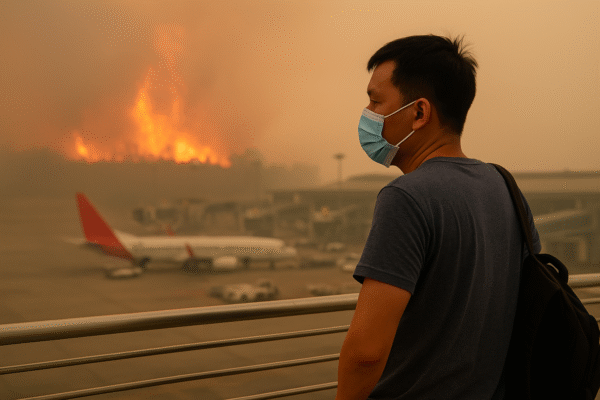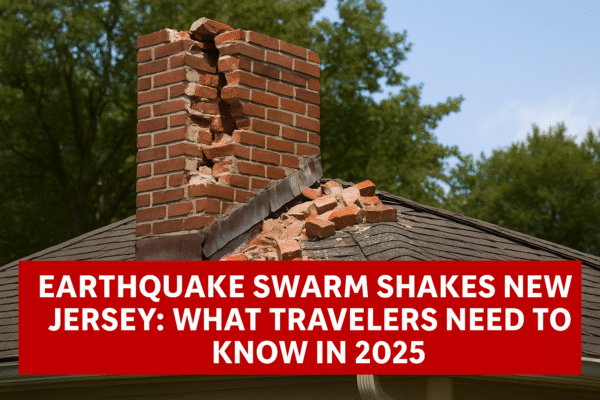MORRIS COUNTY, NEW JERSEY – A rare cluster of six minor earthquakes struck Morris County on July 22, 2025, in what experts are calling one of the most unusual seismic swarms in recent New Jersey history. While no damage was reported, the frequency and timing of the tremors have prompted heightened awareness for residents and travelers alike.
The earthquakes occurred over a span of 17 hours, with magnitudes ranging from 0.7 to 2.0 on the Richter scale. The most affected areas were the suburban communities of Randolph and Mendham—typically quiet locales now at the center of seismic attention.
Timeline of Tremors: A Jarring Day in Suburban New Jersey
According to the United States Geological Survey (USGS), the first quake struck Randolph at 5:40 a.m. with a magnitude of 1.6. Throughout the day, five more tremors followed, including:
- A 1.3 magnitude quake at 2:26 p.m. in Randolph
- A 0.7 magnitude event in Mendham at 5:51 p.m.
- A 1.2 magnitude shake in Randolph at 8:19 p.m.
- The largest of the swarm—a 2.0 magnitude quake—at 9:00 p.m.
- A final 1.1 magnitude tremor at 11:25 p.m.
While these earthquakes are considered minor, their frequency over a short period caused considerable alarm among locals. Loud rumbling, furniture vibrations, and startled pets led to a flurry of 911 calls and online discussions.
Why the Swarm? Understanding the Science Behind It
Seismologists refer to this kind of sequence as an “earthquake swarm.” These events occur when a series of quakes happen without a clear mainshock. In New Jersey, such activity is infrequent but not impossible due to deep-seated fault lines beneath the region.
Stress accumulation in the Earth’s crust or changes in underground water levels may trigger these minor quakes. Experts emphasize that these are not necessarily precursors to a larger event, but they are being monitored with caution.
A State of Calm but Vigilance
The Morris County Office of Emergency Management (OEM) reassured the public via social media that no structural damage or injuries were reported. Emergency services remained fully operational, but the event acted as a wake-up call for preparedness.
Officials encourage residents and visitors to brush up on earthquake safety measures. This includes identifying safe indoor areas like door frames and sturdy tables, securing heavy furniture, and maintaining an emergency go-bag with essentials such as water, first aid, and flashlights.
New Jersey’s Seismic Background: A Hidden Fault Line
Though not widely known for earthquakes, New Jersey has experienced seismic activity throughout its history. The strongest earthquake on record was a 5.3 magnitude event in Cape May in 1884, which caused widespread—but relatively minor—damage across the region.
Since then, smaller quakes have occurred periodically, mostly going unnoticed or mistaken for construction noise or thunder. However, this recent swarm has reignited interest in the state’s geological composition and its potential for seismic shifts.
Psychological Impact: When Stability Is Shaken
Beyond the physical vibrations, residents reported feeling a lingering sense of unease. Earthquakes in regions unaccustomed to such events often induce anxiety, especially when they occur in clusters.
Pets, in particular, seemed more attuned to the shifts. Many owners reported abnormal behavior among dogs and cats prior to each quake—behavior seismologists acknowledge as common due to animals’ heightened sensitivity to ground vibrations.
Advice for Tourists and Travelers
As New Jersey gears up for a busy summer tourist season, officials are advising travelers—especially those unfamiliar with seismic zones—to stay informed. While there’s no current danger, it’s important to remain vigilant and practice basic safety protocols.
Tourists heading to Morris County for leisure or events should:
- Sign up for local alerts through the New Jersey Office of Emergency Management
- Follow USGS real-time quake tracking via the “Did You Feel It?” tool
- Review hotel or accommodation emergency exit plans
- Be aware of the closest open space in case evacuation is needed
Monitoring Continues: USGS and OEM on High Alert
Scientists from the USGS are continuing to monitor the seismic activity using regional ground sensors. At present, the probability of a larger earthquake in the immediate future is considered low, but ongoing tremors could signal additional shifts in crustal stress.
Local emergency agencies are also prepared to escalate their response if needed, reinforcing their partnerships with FEMA and regional seismic monitoring teams.
Looking Ahead: Safety in a Shifting Landscape
While the tremors in Morris County caused no physical damage, their psychological and symbolic impact has been profound. They serve as a reminder that no place is completely immune to natural disruptions—even in states like New Jersey, where seismic activity is rare.
This event, though small in magnitude, underscores the value of preparedness and real-time communication in an era of increasingly unpredictable natural events. Whether you’re a resident, a day-tripper, or a long-term traveler, knowing the risks and being ready can make all the difference when the earth shakes—however slightly.
For more travel news like this, keep reading Global Travel Wire



















